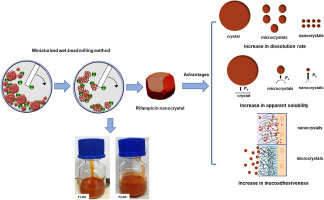Biomaterials Advances ( IF 7.9 ) Pub Date : 2020-03-23 , DOI: 10.1016/j.msec.2020.110895 Katherine Jasmine Curo Melo 1 , Mirla Anali Bazán Henostroza 1 , Raimar Löbenberg 2 , Nádia Araci Bou-Chacra 1

|
Tuberculosis (TB) is one of the top ten causes of death worldwide and a leading cause of death in HIV patients. Rifampicin (Rif), a low water-soluble drug, is a critical first-line treatment and the most effective drug substance for therapy of drug-susceptible TB. However, Rif has high interindividual pharmacokinetic variability, mainly due to its highly variable absorption caused by its poor solubility. Drug nanocrystals are a promising technology to overcome this variability by increasing the surface area. This strategy allows for increasing the dissolution rate and improving the bioavailability of this BCS class II drug. In this study, Rif nanocrystals were prepared by a wet-bead milling method. A 3-factor, 3-level Box-Behnken design was used to investigate the independent variables: the concentration of rifampicin, the concentration of the stabilizing agent (Povacoat® type F), and the mass of zirconia beads. Two optimized formulations, F1-Rif and F2-Rif, were characterized by determining their particle size and size distribution, morphology, crystal properties, and antimicrobial activity. Differential scanning calorimetry (DSC) and powder X-ray diffraction (PXRD) revealed that rifampicin's polymorph II crystal structure was unchanged. The reduced particle size of <500 nm (100-fold decrease) increased the saturation solubility and dissolution rate up to 1.74-fold. The novel polymer, Povacoat®, demonstrated to be a suitable stabilizer to maintain the physical stability of nanosuspensions over two years. The Rif nanocrystals showed antimicrobial activity (0.25 μg/mL) not significantly different from standard rifampicin powder. However, the low cytotoxicity of the nanosuspensions in HepG2 cells was determined. When compared to the commercial product, the nanosuspension increased the rifampicin concentration 2-fold. In conclusion, the Rif nanosuspension allows half the needed volume of administration, which might increase compliance among children and elderly patients throughout the long-term treatment of TB.
中文翻译:

利福平纳米晶体:迈向治疗结核病的创新方法。
结核病(TB)是全球十大死亡原因之一,也是HIV患者的主要死亡原因。利福平(Rif)是一种低水溶性药物,是关键的一线治疗药物,是治疗药物敏感性结核病的最有效药物。但是,Rif具有很高的个体间药代动力学变异性,这主要是由于其不良的溶解性导致其高度可变的吸收。药物纳米晶体是通过增加表面积来克服这种可变性的有前途的技术。这种策略可以提高这种BCS II类药物的溶出度并改善其生物利用度。在这项研究中,Rif纳米晶体是通过湿珠磨法制备的。采用三因素,三级Box-Behnken设计来研究自变量:利福平的浓度,稳定剂的浓度(Povacoat®F型)和氧化锆珠的质量。通过确定它们的粒径和尺寸分布,形态,晶体性质和抗菌活性,对两种优化的配方F1-Rif和F2-Rif进行了表征。差示扫描量热法(DSC)和粉末X射线衍射(PXRD)显示,利福平的多晶型物II晶体结构未改变。小于500 nm的减小的粒径(减小100倍)使饱和溶解度和溶解速率提高了1.74倍。新型聚合物Povacoat®被证明是合适的稳定剂,可在两年内保持纳米悬浮液的物理稳定性。Rif纳米晶体的抗菌活性(0.25μg/ mL)与标准的利福平粉末无显着差异。然而,确定了纳米悬浮液在HepG2细胞中的低细胞毒性。与市售产品相比,纳米悬浮液将利福平的浓度提高了2倍。总之,Rif纳米混悬剂的给药量仅为所需剂量的一半,这可能会在长期的结核病治疗中增加儿童和老年患者的依从性。


























 京公网安备 11010802027423号
京公网安备 11010802027423号